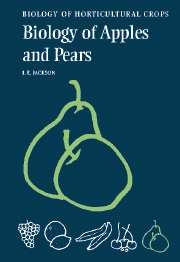Book contents
- Frontmatter
- Contents
- Preface
- Acknowledgements
- Introduction
- 1 The growing of apples and pears
- 2 Apples and pears and their relatives
- 3 Apple and pear root systems: induction, development, structure and function
- 4 The graft union, grafting and budding
- 5 Mechanisms of rootstock and interstock effects on scion vigour
- 6 The shoot system
- 7 Leaves, canopies and light interception
- 8 Photosynthesis, respiration, and carbohydrate transport, partitioning and storage
- 9 Flowers and fruits
- 10 Eating quality and its retention
- 11 Mineral nutrition
- 12 Water relations
- 13 Diseases, pests, and resistance to these
- 14 Biotechnology of apples and pears
- Cultivar Index
- General Index
- References
5 - Mechanisms of rootstock and interstock effects on scion vigour
Published online by Cambridge University Press: 13 August 2009
- Frontmatter
- Contents
- Preface
- Acknowledgements
- Introduction
- 1 The growing of apples and pears
- 2 Apples and pears and their relatives
- 3 Apple and pear root systems: induction, development, structure and function
- 4 The graft union, grafting and budding
- 5 Mechanisms of rootstock and interstock effects on scion vigour
- 6 The shoot system
- 7 Leaves, canopies and light interception
- 8 Photosynthesis, respiration, and carbohydrate transport, partitioning and storage
- 9 Flowers and fruits
- 10 Eating quality and its retention
- 11 Mineral nutrition
- 12 Water relations
- 13 Diseases, pests, and resistance to these
- 14 Biotechnology of apples and pears
- Cultivar Index
- General Index
- References
Summary
Introduction
The use of dwarfing rootstocks for the control of tree vigour is a dominant feature of much of modern apple production and, to a lesser extent, pear production. The mechanism of vigour control by rootstocks has been studied for many years, partly in the hope that understanding the process will lead to its more effective utilization.
The effects of the rootstocks and interstocks are manifold, interactive and cumulative over years. Moreover, different mechanisms appear to be dominant in different species and even in different stock/scion cultivar combinations within a species. In practical terms the dwarfing effect of ‘M.9’ and its derivatives on apple scions and of quince rootstocks on pear scions are probably of the greatest importance so emphasis is given to these within the broader context.
Mechanisms of rootstock and interstock effects on vigour
The mechanisms of rootstock influence on tree vigour are best considered within the concept that the vigour of the composite tree reflects in an additive way the vigour of its components and that these interact. There is, as discussed earlier, a tendency to attainment of a functional equilibrium between roots and shoots. Roots supply shoots with nutrients and water, shoots supply roots with assimilates, and the roots and shoots appear to have specific roles in the production of the plant growth substances that control and coordinate activities in the plant.
- Type
- Chapter
- Information
- The Biology of Apples and Pears , pp. 141 - 156Publisher: Cambridge University PressPrint publication year: 2003
References
- 1
- Cited by



